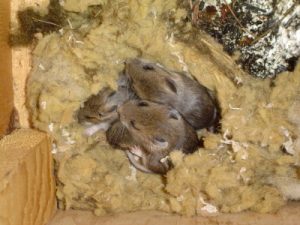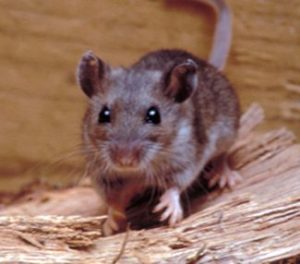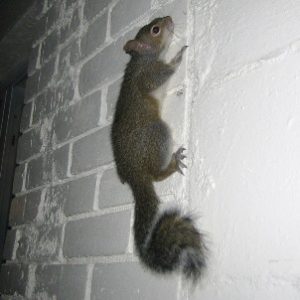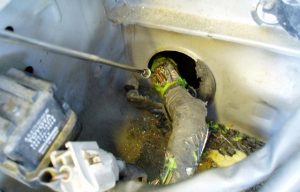Delaying Mice Removal and Repairs Gets Expensive
 A Small Noise That Turned Into a Big Problem. Last winter, a Maplewood homeowner heard what sounded like a faint scratching behind her kitchen cabinets. She brushed it off—probably just the wind, she thought. A few weeks later, she noticed small chew marks near the pantry, then droppings, and finally a musty odor in the basement. By the time she called for help, mice had chewed through insulation, gnawed electrical wiring, and contaminated storage areas. What began as a minor nuisance
A Small Noise That Turned Into a Big Problem. Last winter, a Maplewood homeowner heard what sounded like a faint scratching behind her kitchen cabinets. She brushed it off—probably just the wind, she thought. A few weeks later, she noticed small chew marks near the pantry, then droppings, and finally a musty odor in the basement. By the time she called for help, mice had chewed through insulation, gnawed electrical wiring, and contaminated storage areas. What began as a minor nuisance

 A scratching sound you can’t ignore. It usually starts late at night, a faint scratching or scurrying behind the drywall. At first, you might brush it off as your imagination, but as days go by, the sound grows more frequent. Homeowners and property managers across Minnesota know that this unsettling noise often means one thing: mice have found a way inside your home and into your walls. These tiny invaders don’t just create noise, they cause real damage and health risks if left unchecked. They also have 5 or more litters in one year.
A scratching sound you can’t ignore. It usually starts late at night, a faint scratching or scurrying behind the drywall. At first, you might brush it off as your imagination, but as days go by, the sound grows more frequent. Homeowners and property managers across Minnesota know that this unsettling noise often means one thing: mice have found a way inside your home and into your walls. These tiny invaders don’t just create noise, they cause real damage and health risks if left unchecked. They also have 5 or more litters in one year. It’s a cold Minnesota morning, and as the wind howls outside, a faint scratching noise breaks the stillness in your home. You pause, listening closer and find it’s coming from above. What started as a few harmless sounds quickly turns into a nightly disturbance. When the insulation starts to shift and droppings appear, the reality sets in: uninvited guests have moved in for the winter.
It’s a cold Minnesota morning, and as the wind howls outside, a faint scratching noise breaks the stillness in your home. You pause, listening closer and find it’s coming from above. What started as a few harmless sounds quickly turns into a nightly disturbance. When the insulation starts to shift and droppings appear, the reality sets in: uninvited guests have moved in for the winter. Bats play an important role in Minnesota’s ecosystem, controlling insect populations and pollinating plants. However, when they take up residence inside homes, attics, or other structures, they can quickly become a serious problem for homeowners and property managers. Bat infestations often go unnoticed for months, as these nocturnal creatures are quiet, elusive, and active primarily at night. Recognizing the early warning signs of a bat infestation is key to preventing property
Bats play an important role in Minnesota’s ecosystem, controlling insect populations and pollinating plants. However, when they take up residence inside homes, attics, or other structures, they can quickly become a serious problem for homeowners and property managers. Bat infestations often go unnoticed for months, as these nocturnal creatures are quiet, elusive, and active primarily at night. Recognizing the early warning signs of a bat infestation is key to preventing property When the temperature drops in Minnesota, homeowners aren’t the only ones looking for warmth. Mice begin searching for food and shelter, and unfortunately, your home may provide the perfect environment. These tiny intruders are more resourceful than most people realize, capable of squeezing through the smallest of gaps and quickly turning into a costly problem. Understanding how they sneak in—and how to prevent it—can protect your home and family from the damage and frustration that comes with an infestation.
When the temperature drops in Minnesota, homeowners aren’t the only ones looking for warmth. Mice begin searching for food and shelter, and unfortunately, your home may provide the perfect environment. These tiny intruders are more resourceful than most people realize, capable of squeezing through the smallest of gaps and quickly turning into a costly problem. Understanding how they sneak in—and how to prevent it—can protect your home and family from the damage and frustration that comes with an infestation. The temperatures are beginning to cool down and when you live in Minnesota, that means that it is time to spend more time indoors. With average winter temperatures well below freezing for the winter months, your home becomes your safe haven for the winter season. Now is the perfect time to make sure that your home does not attract unwanted guests like wildlife that are also looking for warmth and shelter
The temperatures are beginning to cool down and when you live in Minnesota, that means that it is time to spend more time indoors. With average winter temperatures well below freezing for the winter months, your home becomes your safe haven for the winter season. Now is the perfect time to make sure that your home does not attract unwanted guests like wildlife that are also looking for warmth and shelter

